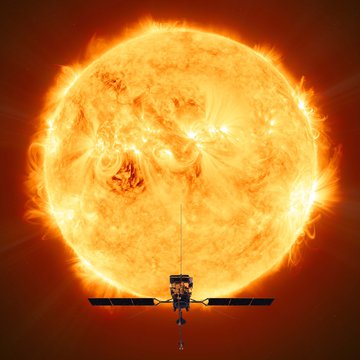Research
Stellar, Solar and Exoplanetary Physics

The research branch “Stars, Sun and Exoplanets” investigates how stars and their planets evolve together, from planet formation to the development of planetary atmospheres and the extremely long time scales on which stars and their magnetism evolve. The Sun - our closest star - serves as a blueprint for processes of other stars that we cannot observe in the same richness of detail. Exoplanets, i.e. planets in other solar systems, can have very different properties to our own eight planets, from their orbits to their composition. Understanding the possibilities for the emergence of life on such planets is one of the big questions that this research branch aims to answer.
Various instrumentation projects and numerical simulations provide us with the basis for new findings. Some avenues that this branch focuses on are high-resolution spectroscopy with the future ELT-ANDES spectrograph, space-based solar observations with Solar Orbiter and magnetohydrodynamic simulations to advance our understanding of stars and their planetary systems.
Extragalactic Astrophysics

Galaxies are fundamental cosmic building blocks. They serve as markers to explore the distribution of matter in the Universe on large scales. Active Galaxies and Quasars are particularly important. Nearby objects can be resolved spatially and are allocated to populations of different kinematics, stellar formation history and chemical abundances. Methods of 3D spectroscopy as an integral part of the technology programme of the institute are especially relevant to these objects. Galaxies in our direct cosmic neighbourhood, and in the Milky Way, can be resolved into individual stars. As stellar populations conserve the chemical and kinematic conditions from the time of their birth, the formation history of those galaxies can be reconstructed in impressive detail and a galaxy becomes a cosmic laboratory.
This relatively new field of research is also known as “Galactic Archaeology” or “Near-field Cosmology”. Theoretical studies further examine and link these different aspects of extragalactic research with high-resolution numerical simulations.
Development of Research Technology and Infrastructure

Owing to the size of the cosmos and the objects within, it is rarely possible to emulate cosmic conditions in terrestrial labs, let alone perform physical experiments with astrophysical objects. Ever improving observations provide the only way to verify the properties of these objects. Astrophysicists observe the sky, mostly using a small number of very large telescopes, which are placed on sites with nearly optimum atmospheric conditions such as Arizona, Chile, or in space. Astrophysics continually pushes the limits of technological feasibility. And today, powerful computer simulations allow to test astrophysical theories and interpretation of observations.
As astrophysical systems are very complex, the demands on the available computer hardware and software are extreme, and astrophysicists have always been amongst the power-users of national and international supercomputer centres.











